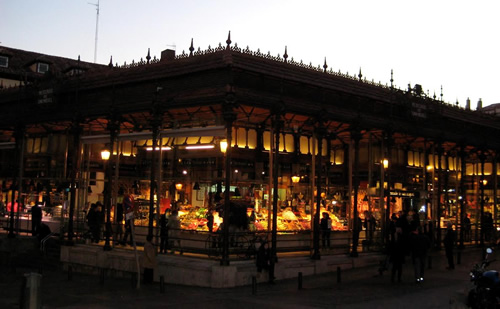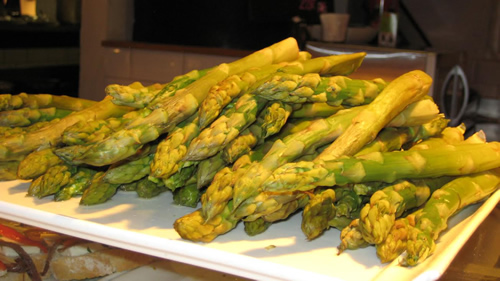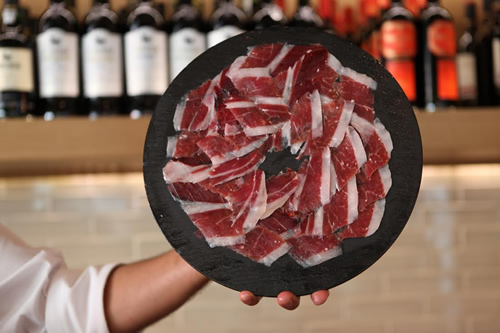Making Madrid Markets More Modern
By DECA GAPBRAVE | ROOSTERGNN Global News Network
Published 1/2/2015

|
|
Mercado San Miguel in Madrid.
|
Mercado de San Miguel
Upon stepping inside Madrid’s Mercado de San Miguel on a Saturday night, you may have a couple of reactions. One, you can feel claustrophobic; the crowds, including many foreigners, are overwhelming. Two, you can acknowledge that you are among the crowd, get over it, and collectively enjoy some of Madrid’s most delicious foods.
Of course, you must decide what you wish to order. Spanish dishes are an obvious choice if you want to sample a wide variety of traditional tastes. From the typical Spanish cerdo ibérico (Iberian pig) to mejillones (mussels) from the South and North, to Valencian paella, the options are many. Homemade sangría is an excellent choice to accompany such fare.
As a madrileño, or as much as a Madrid native you may strive to be, you might succumb to the temptation of a tasty Italian gelato for dessert. Italian ice cream is a recent addition to the market.
During the Medieval period, it was an open-air market for locals. Eventually, a church was built at the exact location. After the church burned down, madrileños created an iron-structured market in 1913. The remaining famous iron structure, conserved since the beginning of the 20th century, is part of the uniqueness and appeal of what is now one of the oldest markets in Madrid.
By the end of the 20th century, however, competition from other markets, such as the Mercados de Monstenses, La Cebada, Chamberi, and La Paz — not to mention the rise of supermarkets — increased. Eventually, the Mercado de San Miguel needed a more modern look to meet the increased competition.
The renovation initiated in 2009 included the current crystal and iron structure, which allows natural light to flow. The 75 stands by the current complex were updated with the help of a company called El Gastronomo de San Miguel, which now owns the majority of the market. International stands and dining options were also introduced, making the market more appealing to a new target audience.
“[The Mercado de San Miguel] is always full, I think they should start adding more seating options,” says Fernando Alcazar, who currently works at the market. “I see people buy a lot of things to take home, but they should also be able to enjoy it here.”
While the Mercado de San Miguel is known for its tapas atmosphere, where people enjoy all the dishes standing up or on bar chairs, other Madrid markets offer sit-down options.

|
|
Fresh asparagus at Mercado San Miguel.
|
Mercado San Antón
Case in point: the Mercado San Antón. First built in 1945 as an open-air market, it declined during the end of the 1990s due to consumer demands and changes in habits. The market was later torn down in 2007 and reopened in 2011 to target the contemporary consumption patterns of both madrileños and tourists.
The renovation consisted of the creation of a modern three-floor, closed market. In the basement, you will find a supermarket, while the top (third) floor includes a restaurant and terrace bar called the Cocina de San Antón, run by the notorious Cinco Jotas. The concept is unique: Besides conventional menu options, you can buy fresh fish and meat downstairs at the market and then take it upstairs to the restaurant. At the Cocina, the fish and meat will then be cooked for you and accompanied as you wish — with vegetables, patatas fritas, or another side dish.

|
|
Jamón at Cocina San Antón.
|
If you have had enough meat and fish during your stay in Madrid, you can also enjoy the tastes of Italy, Greece, America, or Japan from the different stands that now form part of the San Antón Market.
Mercedes Lorenzo, who works at the Bacalao stand, which serves different seafood tapas, says, “There are definitely more tourists now that more stands have been added.” She is surprised that her delicious mix of sweet and seafood tapas is still very popular amongst the tourists visiting the market. “International stands have decreased the number of customers for Spanish stands, but then again, they have also increased the number of tourists,” she says.
Rosa Soto, one of the employees at 24 café, a dessert stand, similarly affirms, “We have an advantage because we are an international dessert stand, so we get people from everywhere around the world, however, our peak hours are in the afternoons and evenings for tapas and drinks.”
While the origins of the Mercado de San Miguel and the Mercado San Antón reach far back in time, new markets such as the Mercado Moncloa are only a few years old.
|
For More Information
Recommendations for Visiting Markets
-
Come hungry.
-
Bring cash.
-
Explore your options before purchasing.
-
Be patient.
-
Be open minded and willing to try new tastes.
-
Seating options may be limited, so be on the lookout to claim your seat.
Madrid’s Most Popular Markets
Mercado San Miguel
A market offering more than just local seasonal food is also a great place to get together.
Plaza de San Miguel, s/n. 28005 Madrid.
Mercado San Antón
You can buy meat and fish at the market, then head upstairs to the Cocina de San Antón to have them cooked to your liking.
Calle de Augusto Figueroa, 2. 28004 Madrid.
|
DECA GAPBRAVE is a student travel guide and forms part of the ROOSTERGNN Global News Network.
|
